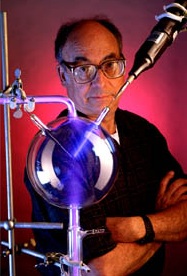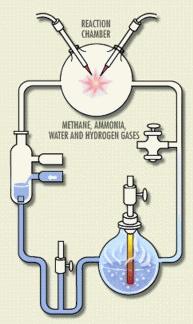
Does life blush? Pink may be the color of nascent energy.
Stanley Miller, in 1951, came to the University of Chicago to study with nuclear physicist Edward Teller who had worked on the Manhattan Project, and later established Lawrence Livermore National Laboratory (where recent success in fusion energy was achieved). While Teller’s student, Miller attended a lecture by Harold Urey, Nobel Laureate in Chemistry, on the Oparin-Haldane hypothesis, on the possible origin of organic life from inorganic compounds. After the lecture, Miller approached Urey with an idea for an experiment to test the hypothesis. Urey was skeptical – no one had ever proven the mystery of how life began – but intrigued. The professor granted Miller one year of funding.

Using water (H2O), methane (CH4), ammonia (NH2), and hydrogen (H2) in a mixture – and stimulating them with an electric arc that acted like lightning to produce fast intense heat and then applying a condenser to cool – Miller repeated alternation of heat and cold to see what might happen. The mix of components has the acronym WHAM (water, hydrogen, ammonia, methane).

Soon, water droplets began to form and then a watery solution dripped into what started to look like a tiny pond. Miller left the lab for the night. The next day, he awakened with curiosity and dashed to the lab. The pond was now turning color – a pale pink. Encouraged, he ran to tell Urey. The two watched and waited. In a week, the pink pond turned a reddish brownish black. What was happening?

Miller identified five amino acids that had formed: aspartic acid, glycine, a-aminobutyric acid and two forms of analine (Australian Earth Science Foundation, 2024). This was significant because previous to that moment, all of science avowed that amino acids, molecules of life, could only be built inside living bodies. That belief was traditionally expressed in the phrase “Omne vivum ex vivo“ (All life comes from living things). But now living energy had appeared from inorganic compounds in Miller’s lab. “Primordial soup” – the parlance given to Oparin/Haldane’s hypothesis and picked up by Miller/Urey – was now served. And it was pink.

Professor Harold Urey urged Miler to publish the findings but refused to put his name on the paper for two reasons. First, the idea and experiment was totally Miller’s and the professor was just the verifier. And, Urey worried – with reason – that the journal editors would give him all the credit because of his Nobel status. As predicted, the journal turned down the paper. But Urey wrote them a very clear note about Miller, attached his name as verifier, and they immediately published the findings. Eventually, the experiment became known as Miller-Urey. Harold Urey is also known from discovering deuterium, an isotope of hydrogen, and the process of enriching uranium. Later in life, Urey became interested in space, participating in examination of lunar rocks brought back by Apollo NASA astronauts. A crater on the moon is now named Urey Crater.

Miller-Urey’s demonstration that organic life can spring from inorganic, under certain conditions, recently made news when scientists noted that Last Chance Lake – a shallow body of water in British Columbia – has the highest concentration of phosphate ever found in any natural pond or body of water on Earth. Why is this interesting? Phosphate contains phosphorus, a life-related molecule found in DNA, RNA, and, well, life. Last Chance Lake also has dolomite that triggers reactions among calcium, magnesium, and carbonate. In the geology of the volcanic soil around the lake, phosphate may have been part of how life originated. In geological circles, it’s called a “soda lake;” some say it is just the kind that Darwin envisioned when he wrote to his colleague in February 1871 about a hypothetical “warm little pond.” But as Miller-Urey proved, it is the stimulus and alternation of heat energy that sparked those components to organic life in that pond and in the lab.

Tesla also placed importance on alternating current. But the idea is not new. Tantra, a philosophy arising around 500 ce in India, proposed that “Spanda” (from Sankrit Spadi “to move back and forth, to vibrate”) was the original energetic force that gave forth life.

The world’s future depends upon energy in clean, renewable, sustainable forms. Solar, wave and wind (caused by thermal alternation), and advances in fusion energy, may lead the way. Interestingly, plasma fusion energy from hydrogen radiates a series of colors from red to aqua, but when they combine, they often produce pink. (Eurofusion 2024). What is it about pink?
Australian Earth Science Foundation. “Origin of Life: Miller-Urey.” https://ausearthed.com.au/wp-content/uploads/2020/06/Origin-of-Life-Miller-Urey-Reading.pdf
Brooke, K. Lusk. “Energy: Darwin’s Big IF and the Oparin-Haldane Hypothesis.” 1 February 2024. https://blogs.umb.edu/buildingtheworld/2024/02/01/energy-darwins-big-if/
Center for Chemical Evolution (CCE). https://centerforchemicalevolution.com
Darling, David. “Oparin-Haldane Theory: Chart on Differences in Theories of Oparin and Haldane” https://www.daviddarling.info/encyclopedia/O/OparinHaldane.html
Eurofusion. “Where does the plasma colour come from?” 2024. https://euro-fusion.org/faq/where-does-the-plasma-colour-come-from/
Forsythe, Jay G., et al., “Ester-Mediated Amide Bond Formation Driven by Wet-Dry Cycles: A Possible Path to Polypeptides on the Prebiotic Earth.” 15 July 2015. Angewandte Chemie, Volume 127, Issue 34, pages 10009-10013. https://onlinelibrary.wiley.com/doi/10.1002/ange.201503792
Gronstal, Aaron. “Origins of life in a drying puddle.” 10 August 2015. National Science Foundation and NASA. https://astrobiology.nasa.gov/news/origins-of-life-in-a-drying-puddle/
Horn-Muller, Ayurella. “A shallow lake in Canada could point to the origin of life on Earth.” 17 February 2024. CNN. https://www.cnn.com/2024/02/17/world/last-chance-lake-origin-of-life-phosphate-scn?cid=ios_app
Mitnick, Michael. “The Current War.” Film starring Benedict Cumberbatch as Thomas Edison, Nicholas Hoult as Nikola Tesla, and Michael Shannon at George Westinghouse. Premiered 2017. https://www.imdb.com/title/tt2140507
National Institute of Standards and Technology (NIST). “Atomic Spectra Database.” Version 5.11, December 2023. https://www.nist.gov/pml/atomic-spectra-database
Stated Clearly. Narrated by Jon Perry. “What was the Miller-Urey Experiment?” Center for Chemical Evolution, National Science Foundation, and NASA. https://youtu.be/NNijmxsKGbc?si=iHSgQ0wK5ZoHP_g
Thomas, Jeremy. “Igniting the Future.” 15 May 2023. Lawrence Livermore National Laboratory (LLNL). https://www.llnl.gov/article/49786/igniting-future-hundreds-gather-celebrate-historic-fusion-achievement
Building the World Blog by Kathleen Lusk Brooke and Zoe G. Quinn is licensed under a Creative Commons Attribution-NonCommercial-NoDerivs 3.0 U
